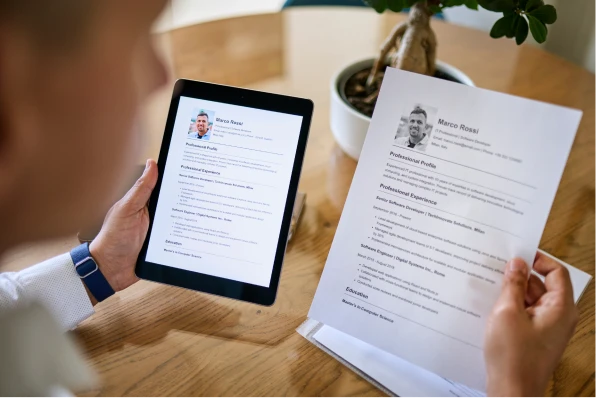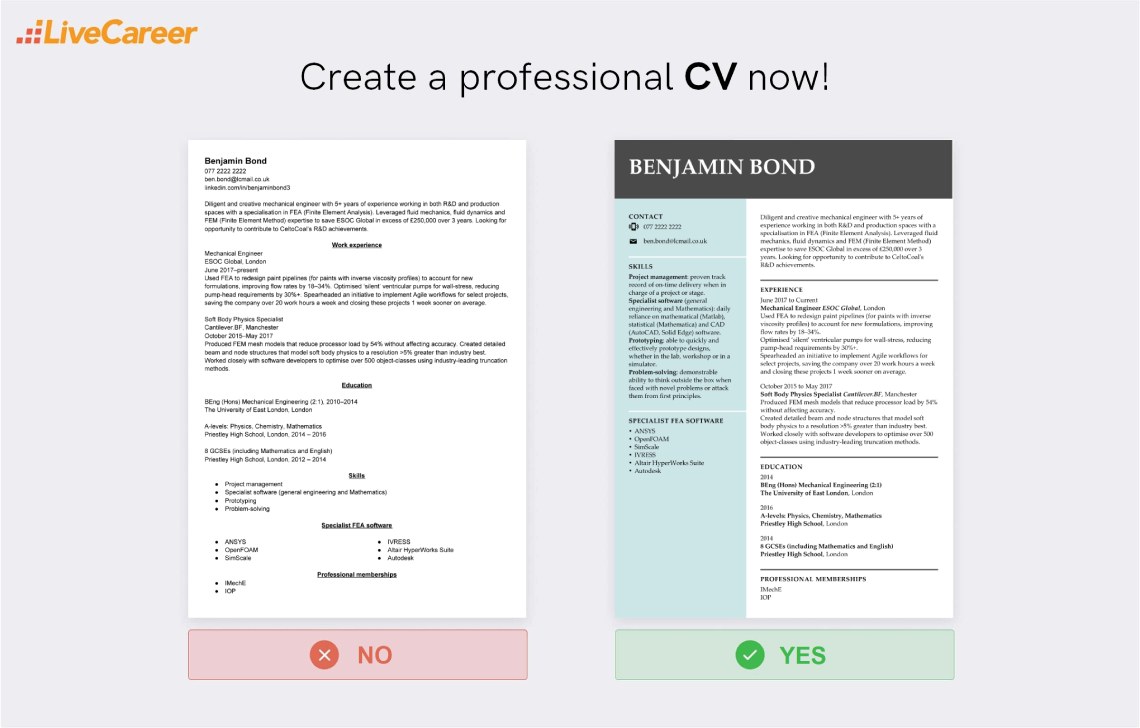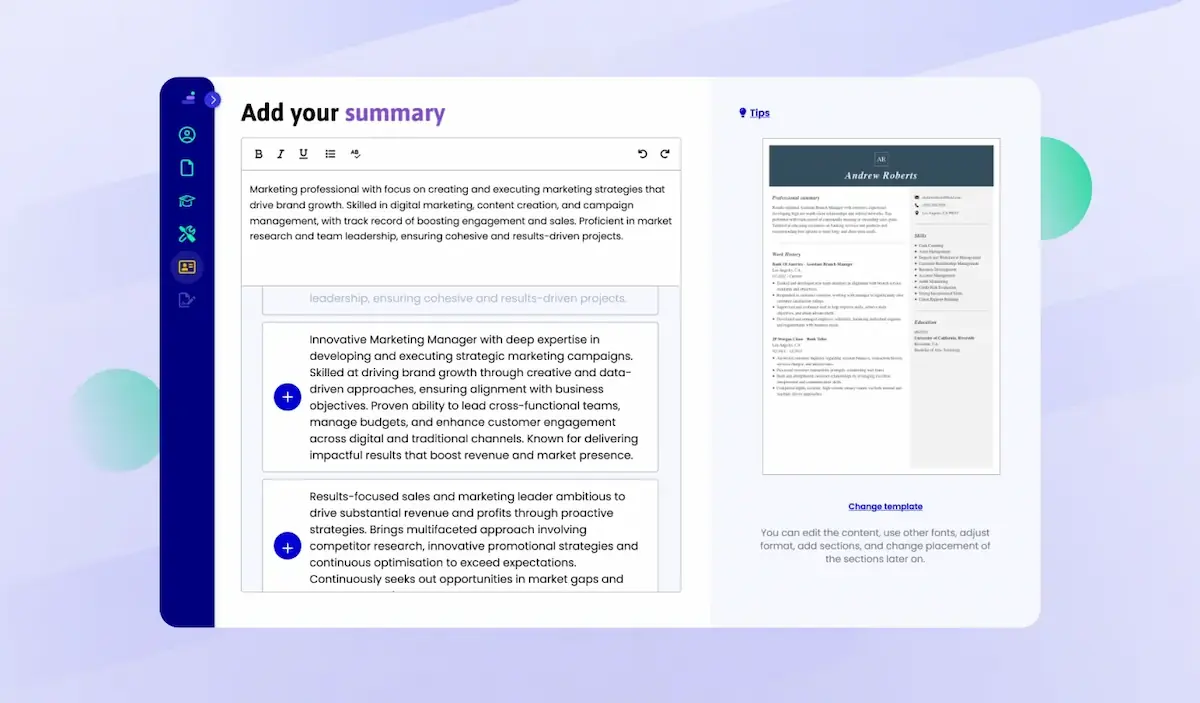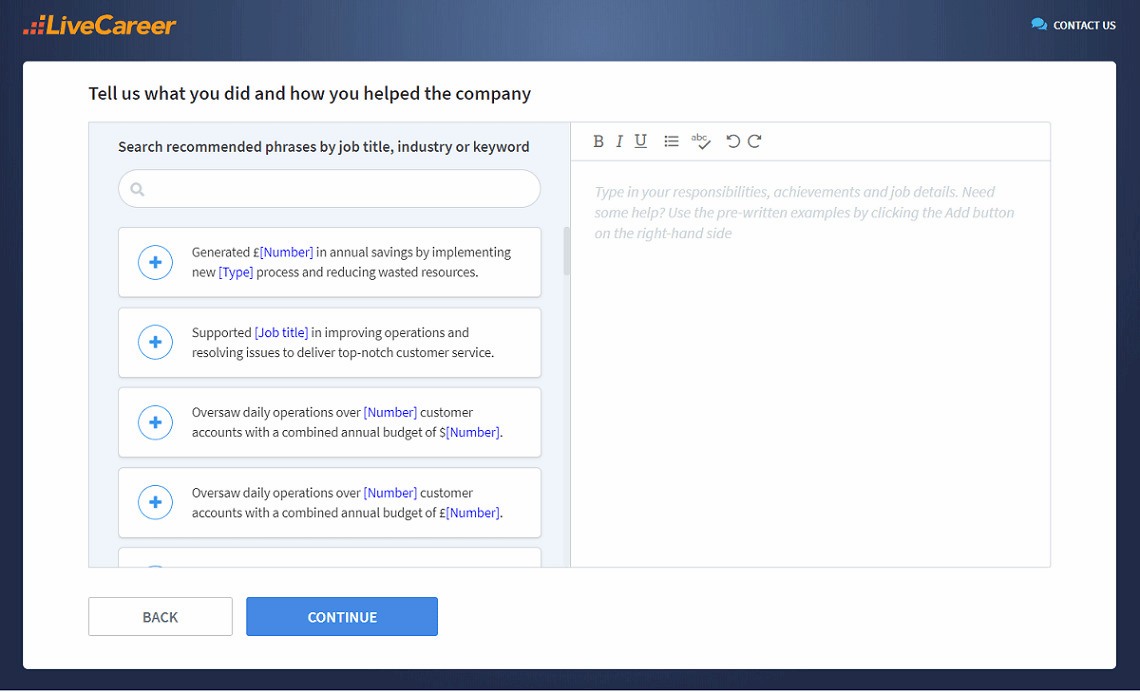![Football CV Example, Template & Writing Guide [2026]](https://cdn-images.livecareer.co.uk/pages/football_cv_lcuk_1.jpg)
Football CV Example, Template & Writing Guide [2026]
Not sure how to write a football CV? Read this guide for a football CV template you can customise to your needs and expert tips to impress scouts and clubs!
December 29, 2025
Last updated on 17 November, 2025

Writing a strong CV summary can feel like a daunting task. How do you highlight your best achievements and top skills in just a few sentences, without overwhelming the reader? It might seem tricky at first, but it’s absolutely doable—and well worth the effort.
In this article, I’ll show you what a CV summary is and why it matters. You’ll get practical tips, learn how to craft your own, and see standout examples that grab recruiters’ attention right away. Let’s dive in.
Create an effective CV in minutes. Choose a professional CV template and fill in every section of your CV in a flash using ready-made content and expert tips.

A CV summary is a brief section positioned at the top of a CV that highlights your key skills, professional achievements, and career goals. It typically consists of 3 to 5 concise sentences that highlight your most relevant qualifications, helping to capture the employer’s attention.
Here’s a CV summary example to explain it even more clearly:
Dynamic IT Specialist with 8+ years of experience managing IT infrastructure and providing technical support. Proficient in network administration, cybersecurity, and cloud computing. Led IT solutions at Smart Solutions, improving efficiency by 30% and saving $500K annually. Seeking a role at TechGenius to drive digital innovation.
This sample summary for a CV ticks all the boxes: it emphasises the candidate's skills, experience, and notable achievements, effectively showcasing their value proposition to potential employers.
A good CV summary is:
• Targeted to a specific job or employer.
• Relevant to the job requirements.
• Brief and easy to understand for the reader.
• Catchy, specific, and compelling.
• Free of jargon, errors, and vague wording.
In today’s labour market, recruiters often sift through numerous applications to identify the best candidates quickly. Including a CV summary allows you to present your professional qualifications, making it easier for employers to assess your suitability for the role at a glance. This encourages recruiters to delve deeper into your CV, improving your chances of getting an interview.
Every good personal summary for a CV has to do the following three things:
Here’s a CV summary example that does the above:
Diligent Mechanical Engineer with 5+ years of experience in R&D and production environments, specialising in Finite Element Analysis (FEA) and advanced fluid mechanics. Proven ability to deliver performance improvements, cost savings, and innovative solutions—credited with saving ESOC Global over £250,000 within 3 years. Adept at leveraging engineering simulation tools and Agile project methodologies to drive efficiency and precision. Currently seeking a role in CeltoCoal’s R&D division to contribute cutting-edge solutions to mechanical challenges.
A strong CV summary will convince the recruiter you’re the perfect candidate. Save time and choose a ready-made personal statement written by career experts and adjust it to your needs in the LiveCareer CV builder.

Creating a compelling summary for a CV takes planning. Before you start, make sure you’ve covered these steps:
Ensure that your personal summary for a CV addresses specific expectations and requirements outlined in the job ad. A good summary for a CV focuses on your experiences and professional goals, but it also demonstrates your alignment with the company’s values and missions. Research the company and its culture to gain insight into its direction and objectives.
In your CV summary, highlight your expertise, years of experience, and a key trait.
You can also mention your area of specialisation to help recruiters quickly see if you’re a good fit.
Recall 1–2 standout achievements that are related to the job you’re interested in. Use short, dynamic sentences that present quantifiable information, demonstrating your professionalism and efficiency. Use keywords from the job description to make your CV summary more targeted and relevant.
CV summary example highlighting achievements
Results-oriented Digital Marketing Manager with 6+ years of experience driving successful digital campaigns. Led a team in developing a multichannel digital marketing strategy at ApexTech, resulting in a 40% increase in website traffic and a 25% growth in lead generation within 6 months. Implemented data-driven approaches to optimise campaigns, resulting in a 30% jump in conversion rates and a 20% cut in cost per acquisition. Seeking a digital marketing manager position to drive growth and exceed business objectives at Giga Bites.
Mention the key skills and traits, including technical skills, that make you a great fit for the given position. You can highlight your skills in combination with your accomplishments and experiences, or specify particular skills that make you a standout candidate. If there are any areas of your work that you feel particularly confident about, add them.
CV summary example focusing on skills
Highly trained Software Developer proficient in Java, Python, and C++. Distinguished for the development of a customer management system at Skyline Software Solutions, resulting in a 25% improvement in efficiency. Skilled in using frameworks like Spring Boot and Django to streamline development and deliver quality software solutions. Possesses a strong understanding of software engineering principles, with expertise in Agile methodologies and test-driven development (TDD). Motivated to join BlueTech Inc. to drive impactful projects.
At the end of your CV summary, say how you want to contribute to that particular company and what value you can add as an individual. How do you want to utilise your skills and expertise? How could the company benefit from your experience? Be sure to mention the company name as well as the job title.
Below are CV summary examples for some of the most sought-after jobs in the UK, showcasing the skills, experiences, and achievements that can make a candidate shine:
Organised and results-driven Project Manager with more than 6 years of experience leading complex projects to successful completion. Excellent at project planning, risk management, and stakeholder communication. Managed a cross-functional team at BuildSmart, delivering a major infrastructure project on time and under budget, achieving a 25% increase in client satisfaction. Seeking a Project Manager role at ProjectSuccess to drive impactful projects and achieve organisational goals.
Results-driven Marketing Manager with 9 years of experience developing and executing successful marketing campaigns. Proficient in market research, brand management, and digital marketing strategies. Coordinated a rebranding initiative at MarketMasters, increasing brand awareness by 50% and driving a 35% boost in sales. Excited about the opportunity to join BrandSpark as a Marketing Manager to contribute to innovative marketing strategies and business growth.
Organised and detail-focused Administrative Assistant with 5 years of experience supporting office operations and streamlining administrative processes. Skilled in calendar management, document preparation, and customer service. Successfully implemented a new filing system at GreenTech Solutions, reducing retrieval time by 40% and improving team efficiency. Eager to join BrightPath Ltd as an Administrative Assistant to contribute to smooth office management and enhance organisational effectiveness.
Passionate Teacher with 4+ years of experience delivering engaging and effective instruction. Proficient in curriculum development, classroom management, and differentiated instruction. Spearheaded a literacy program at BrightFuture School, increasing student reading levels by 25% and fostering a love for learning. Eager to join LearnWell Academy to inspire and educate the next generation through creative and dynamic teaching methods.
Empathetic Nurse with more than 3 years of experience providing comprehensive patient care and clinical support. Proficient in emergency response, patient education, and chronic disease management. Initiated the development of a patient triage system at CareWell Hospital, resulting in a 30% reduction in wait times and improved patient satisfaction. Highly interested in a nursing role at LifeCare Hospital to provide exceptional patient care and support healthcare excellence.
Analytical and results-driven Financial Analyst with 7+ years of experience in financial planning and analysis. Expert in financial modelling, budget forecasting, and data analysis. Implemented a financial reporting system at FinancePros, resulting in a 20% increase in accuracy and a 15% reduction in reporting time. Motivated to join WealthStrategies as a Financial Analyst to support strategic decision-making and financial optimisation.
Innovative and detail-oriented Software Engineer with 5+ years of experience developing scalable software solutions and improving application performance. Proficient in Python, Java, and cloud technologies such as AWS and Azure. Designed and implemented an AI-based customer feedback system at CodeFlow Solutions, boosting user engagement by 30% and reducing processing time by 50%. Eager to join TechPioneers to develop cutting-edge software that enhances user experience and drives innovation.
Analytical Data Scientist with 7+ years of experience managing and analysing large datasets to drive strategic business decisions. Proficient in various data analysis tools, machine learning algorithms, and statistical methods. Led the development of predictive models at DataInsights, improving sales forecast accuracy by 40% and saving over $300,000 annually. Seeking a Data Scientist role at TechGenius to contribute to the company's mission of leveraging data for innovative solutions and business growth.
Dedicated Civil Engineer with over 5 years of experience designing and managing infrastructure projects. Proficient in structural analysis, project planning, and site supervision. Led the successful renovation of the Riverbridge Bridge, improving safety standards and reducing maintenance costs by 30%. Seeking a Civil Engineer role at UrbanBuild to contribute to sustainable and efficient infrastructure development.
Strategic and people-focused Human Resources Manager with 8+ years of experience leading HR initiatives in recruitment, talent development, and employee engagement. Spearheaded a company-wide diversity programme at PeopleFirst Ltd., increasing workforce diversity by 25% and improving employee retention rates by 20%. Skilled in conflict resolution, compliance management, and workforce planning. Excited to join TalentHub to drive organisational growth through innovative HR practices and employee development strategies.
Even if you haven’t held a paid job before, you can still create a strong CV summary by focusing on relevant activities and qualities. Start by highlighting any volunteer roles, internships, and placement work you’ve done. For example, mention specific tasks you handled, skills you developed, or positive outcomes you contributed to during these experiences.
If you haven’t had these opportunities yet, don’t worry. In this case, write a statement that explains why you’re motivated and how your values align with the company. Research the company, its mission, values, and read about its corporate culture.
Plus, you can lean on academic achievements and any relevant project work you’ve done. Check out our guide on how to write a student CV, which shows how to approach a personal summary for a CV before you’ve got any real work experience to speak of.
Dynamic and motivated Marketing Associate with a solid background in marketing, coupled with initial experience in market research, data analysis, and marketing campaigns. Proficient in utilising digital marketing tools and platforms to enhance brand visibility and drive consumer engagement. Coordinated social media campaigns during a marketing internship at Skyline Solutions, resulting in a 20% increase in online engagement. Seeking an entry-level marketing associate position at Buzz Masters to contribute to the company's marketing objectives.
Here are some additional tips to make your CV summary encourage employers to get in touch with you:
Be as specific and concrete as you can. In your CV summary, quantify the benefits you brought to your employer and put as many numbers as you can.
Include a strong, dynamic verb to start each achievement, such as ‘negotiated’, ‘led’, ‘achieved’, ‘produced’, ‘saved’, or ‘developed’. Structure each point as an accomplishment statement, clearly showing what you did.
Make your personal summary for a CV brief and focused. Choose the most essential information, and aim for 3–4 sentences so that your CV doesn’t exceed one page. Don’t go over 50–150 words in total.
Generic, worn-out statements won’t make your CV summary stand out against other candidates. Try to reflect your individuality, your unique traits, and key strengths that make you a professional everyone loves to work with.
Your CV summary comes first in your application, but don’t feel pressured to write it immediately. Having worked through and prepared your work experience section with job descriptions, writing the CV summary will become much easier.
You don’t have to be a CV writing expert. In the LiveCareer CV builder you’ll find ready-made content for every industry and position, which you can then add with a single click.

Trust me, these tips will put you on the road to an effective CV summary. Writing the first one can be challenging, but it becomes much easier with practice.
Our editorial team has reviewed this article for compliance with LiveCareer’s editorial guidelines. It’s to ensure that our expert advice and recommendations are consistent across all our career guides and align with current CV and cover letter writing standards and trends. We’re trusted by over 10 million job seekers, supporting them on their way to finding their dream job. Each article is preceded by research and scrutiny to ensure our content responds to current market trends and demand.
Category: CV Help
Crafting a job-winning CV is all about showcasing your unique skills and experiences. Start with a strong personal statement that highlights your career goals and achievements.
Try Our CV Builder Now